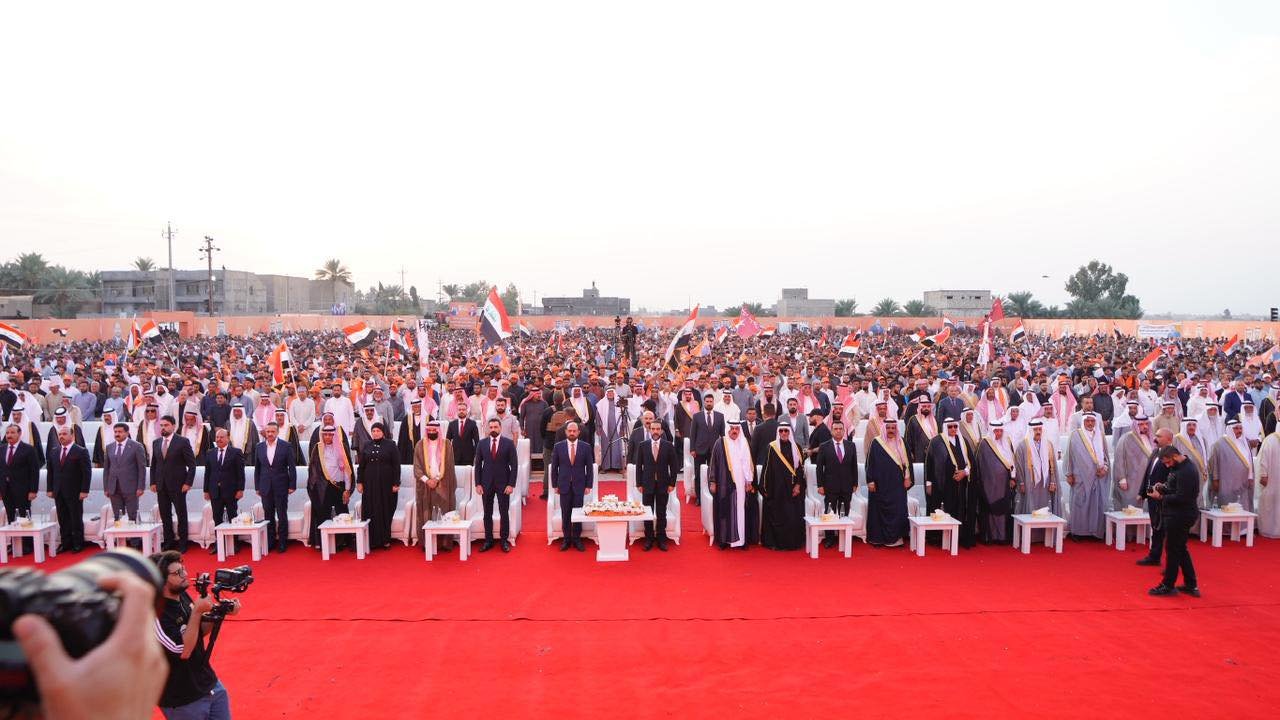Baghdad’s Sunni political scene is entering a fierce contest ahead of the legislative elections slated for November 11, as parties vie for the largest possible share of the capital’s more than 70 seats with an eye to leading the “Sunni house” and shaping the next parliament’s leadership. The sharpest struggle is between Mohammed al-Halbousi’s Taqaddum Party, Muthanna al-Samarrai’s Azm Alliance, Khamis al-Khanjar’s Sovereignty Alliance, and the Hasm Alliance led by Defense Minister Thabet al-Abbasi, though observers rate Hasm’s chances as the weakest.
Home to roughly 10 million people, Baghdad carries the greatest electoral weight in the country: 69 seats plus two minority “quota” seats out of the parliament’s 329, the largest bloc by far compared with other provinces. Beyond the arithmetic, the capital also holds symbolic and historic weight: ruled by Sunni dynasties for centuries and the seat of the Abbasid caliphate, it has, since 2003, been administered by a Shiite-led ruling elite, an arc that all sides in today’s race invoke in different ways.
Electorally, the capital is being carved into partisan strongholds. Taqaddum leans on Adhamiya, pockets of Karkh on the city’s west bank, the Abu Ghraib district, and parts of southern Baghdad; al-Halbousi himself is running in the capital to maximize the slate’s haul. Sovereignty, which relies on Baghdad more than other provinces, is focusing on Karkh-side neighborhoods such as Yarmouk and Saydiya, the Taji district, and districts to the south and north, bolstered by the appeal of Laith al-Dulaimi and Mahmoud al-Mashhadani in Sunni-majority suburbs. Azm, led by al-Samarrai, is concentrating on Amiriya, Ghazaliya, Adl, and Khadra in Karkh and, as analyst Muhannad al-Rawi notes, retains solid support in Abu Ghraib, Tarmiyah, and al-Mashahda.
Sunni factions frame the Baghdad race as a test of presence and weight—an effort to demonstrate that the Sunni component is not marginal in the capital. Their message stresses mass mobilization, urging high turnout in Karkh’s neighborhoods, Adhamiya, al-Fadl, Dora, and across the Baghdad Belt to “prove” that argument at the ballot box.
Amid this tightening race, competition for seats is intensifying. Some 8,000 candidates are in contention, even as attention turns to mounting disputes within the Sunni camp, whose electorate spans Anbar, Nineveh, Salah al-Din, Diyala, Baghdad, and Kirkuk, with pockets in Babylon, Wasit, and Basra as well. The Baghdad contest is shaped by overlapping strongholds and mutual efforts to secure a majority of the city’s seats. This cycle, Sunni parties are trying to reassert themselves through broad participation and a capital-first strategy, hoping to benefit from the Sadrist movement’s absence, which could open additional space for Sunni lists. Historically, Sunni forces and alliances have won roughly 75–80 seats nationwide; many in the camp expect that tally to rise this time—especially in Baghdad—if mobilization lifts turnout.
Mapping Sunni Competition in Baghdad — Preview
Sunni presence: concentrated in Karkh (west-bank)’s neighborhoods and districts, as well as in Adhamiya on the Rusafa (east-bank) side, and across the Baghdad belt—Tarmiyah, al-Mashahda, Taji, Latifiya, and Radwaniyah—along with the Abu Ghraib district.
Trend: Sunni blocs historically ~75–80 seats nationwide; expected uptick with Sadrist boycott & turnout drive.
Taqaddum
Leader: Mohammed al‑Halbousi
1st
Focus areas
Adhamiya, pockets of Karkh, Abu Ghraib, and parts of southern Baghdad.
How they campaign
- Leader‑led vote maximization via al‑Halbousi’s Baghdad candidacy.
- Distributing personal votes across a strong party slate.
Notable figures
Ammar al‑Hamdani (Baghdad Provincial Council), Ali Hamid al‑Dulaimi (ex‑Education Minister)
Azm Alliance
Leader: Muthanna al‑Samarrai
2nd
Focus areas
Amiriya, Ghazaliya, Adl, Khadra, plus support in Abu Ghraib, Tarmiyah, and al‑Mashahda.
How they campaign
- Tribal alliances (e.g., al‑Mashahda, al‑Ghurair).
- List anchored by Mahmoud al‑Qaisi.
Notable figures
Rafi’ al‑Mashhadani; Leaders of al‑Ghurair; Mahmoud al‑Qaisi
Sovereignty Alliance
Leader: Khamis al‑Khanjar
3rd
Focus areas
Yarmouk and Saydiya, Taji district, southern districts, and northern suburbs.
How they campaign
- Networks with Madkhali‑influenced mosques (Yarmouk, Dora, Saydiya, Amiriya, Abu Ghraib, belt).
- Al‑Khanjar’s capital‑first push.
Notable figures
Laith al‑Dulaimi; Mahmoud al‑Mashhadani
In February 2023, parliament amended the election law to adopt a 1.7 divisor under the Saint-Laguë system. The move sparked controversy among activists and independents, who argued it was tailored to entrenched powers and effectively restores a single-district approach.
While several lists are in the field, most expect the real contest in Baghdad to narrow to three: Taqaddum, Azm, and Sovereignty. Hasm, whose base lies in Nineveh, is not expected to take more than a couple of seats. Taqaddum is front-loading al-Halbousi’s candidacy to generate a large personal vote that can lift other party contenders; it is also fielding strong figures such as Baghdad Provincial Council chairman Ammar al-Hamdani and former Education Minister Ali Hamid al-Dulaimi. Azm is leaning on alliances with tribal sheikhs—including Rafi’ al-Mashhadani of the al-Mashahda tribe and leaders of the al-Ghurair tribe—while relying on the prominence of its list leader, Mahmoud al-Qaisi. Sovereignty, for its part, draws on ties with Madkhali Salafists influential in mosques in Yarmouk, Dora, Saydiya, Amiriya, Abu Ghraib, and parts of the Baghdad Belt, and al-Khanjar is concentrating his efforts on the capital more than on the provinces.
According to Sunni political researcher Ahmed al-Tamimi, the likely pecking order in Baghdad’s Sunni context has Taqaddum first with 10 to 12 seats, Azm on 7 to 9, Sovereignty on 4 to 6, and Hasm on one or two at best, given its Nineveh-centric base. Former MP Talal al-Zoba’i goes further, arguing that Sunni wins in the capital “will not be fewer than 33 of Baghdad’s 69 seats,” and that the number of Sunni MPs nationwide could surpass 100 if one counts figures elected on Shiite-led lists such as the Reconstruction and Development list headed by Prime Minister Mohammed Shia’ al-Sudani and those led by Popular Mobilization Forces chief Falih al-Fayyadh.
Sunni presence in the capital is concentrated in Karkh (west-bank)’s neighborhoods and districts, as well as in Adhamiya on the Rusafa (east-bank) side, and across the Baghdad belt—Tarmiyah, al-Mashahda, Taji, Latifiya, and Radwaniyah—along with the Abu Ghraib district.










